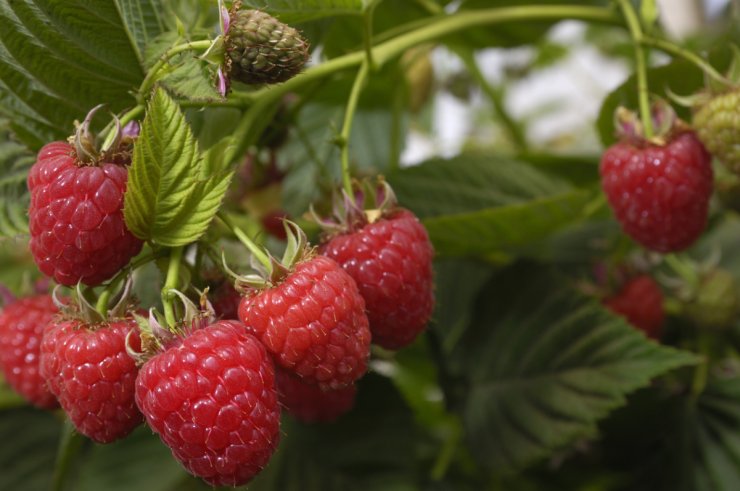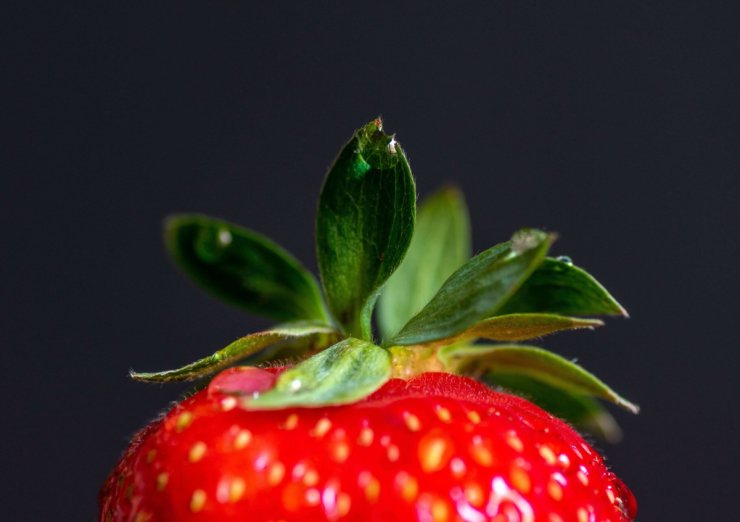
I love berries. They’re fantastic snacks on their own. Many of them are great in a pie for dessert or with some yogurt and granola for breakfast. You can add them to drinks (strawberry lemonade, anyone?), and they bring a touch of sweetness to savory recipes. But with so many to choose from, which are the best berries to grow in your garden?
Berries come in a variety of “packaging.” Strawberry plants are small enough that you can plant them in a hanging basket, while blackberry brambles can grow 5 feet or taller and spread 3 to 4 feet wide. That’s definitely a factor in considering what you want to grow.
Additionally, factors like soil and climate play a huge role in selecting the best berries to grow in your garden. Blueberries, for example, are somewhat famous for needing acidic soil, while some varieties of blackberries are considered invasive and will grow anywhere they can.
How sweet it is
One factor in determining which are the best berries to grow in your garden is what you want to eat. How sweet is a particular berry and will you like it? One way to measure the sweetness is with the Brix scale. Here’s what we wrote about the Brix scale in measuring the sweetness of tomatoes:
Brix is perhaps the most well-known in the world of winemaking. Here’s how Dawson Raspuzzi describes it in WineMaker magazine:
Brix “is the percentage of sugar by weight in a liquid. The sugar level is determined by the specific gravity of the juice, and because water has a specific gravity of 1, Brix can also be expressed as a percentage of sugar in the liquid. For instance, if a juice measures 20 °Brix, that means the juice is 20% fermentable sugar.”
So, a higher Brix score means the tomato has more sugars, aka is sweeter. But there’s a catch.
The Brix rating is not necessarily uniform across a particular variety of tomatoes. Soil health and composition, sunlight, water, temperature, and other factors all play a role in how sweet any particular tomato is.
Nor does a high Brix rating always equate to great flavor. For example, while you and I might enjoy sweet tomatoes, some people prefer them on the more mellow side. That’s okay, too.
Remember, like so many other measurements, the Brix scale is simply a tool to guide you. It’s a reference point. It’s a decent way to avoid the heartache of lovingly tending to a tomato plant for months, only to find out the fruit is bland.
While that was specific to tomatoes, the concept applies to berries, as well. I also might add that a Brix measurement isn’t always available, so some of these berries don’t have an “official” sweetness rating.
With that in mind, here are 10 of the best berries to grow in your garden.
What will you grow? Here are 10 of the best berries to grow in your home garden (in alphabetical order)!
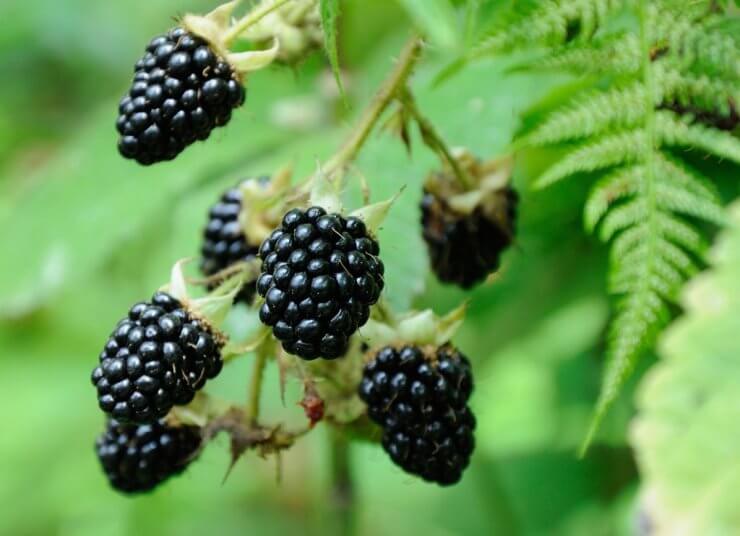
Blackberries
Image courtesy of University of Washington.
1. Blackberries
Blackberries (Rubus fruticosus) grow in what are known as brambles. A bramble is a thick shrub, often with thorns, although there are thornless varieties of blackberries. Blackberries are both perennial and biennial. The roots are perennial, while the canes produce fruit every two years and die off.
Zones: Most blackberries grow in USDA Plant Hardiness Zones 5 to 8, though some varieties will grow as far north as zone 3 and as far south as zone 10.
Plant spacing: Plant blackberries 3 feet apart, with 8 feet between rows. Blackberries can grow to 9 feet tall and 9 feet wide.
Sweetness scale: 9 to 10; blackberries are known for their juicy sweetness.
Invasive or not: Blackberries are native to North America, South America, Europe, and Asia; however, they grow so quickly that they are considered an invasive species in some areas, particularly the Pacific Northwest.
Effort: Perhaps the most challenging part of growing blackberries is keeping them pruned so they don’t take over your entire garden. If you don’t mind regular pruning, these can be some of the best berries to grow, as they can be quite prolific. After a cane produces fruit in the second year, prune them back so new canes can grow more easily. Pruning also increases fruit yield the following year.
Sun: Blackberries prefer a full six to eight hours of sunlight.
Size: The “average” blackberry will reach heights of 4 to 6 feet with a spread of 3 to 5 feet, however, some varieties can grow much larger.
Soil: Although blackberries are highly adaptable, they prefer loamy, well-drained soil with a pH of 6.0 to 7.0.
Watering: Blackberries need consistent moisture their first year, but after that, regular rainfall is likely enough to keep them happy.
Companion fun fact: Like blackberries, catmint will grow in almost any environmental conditions. Plus, once catmint flowers, it attracts pollinators like bees and it deters some pests.
Want to learn more about growing blackberries? Check out our gardening guide, Blackberry Heaven!
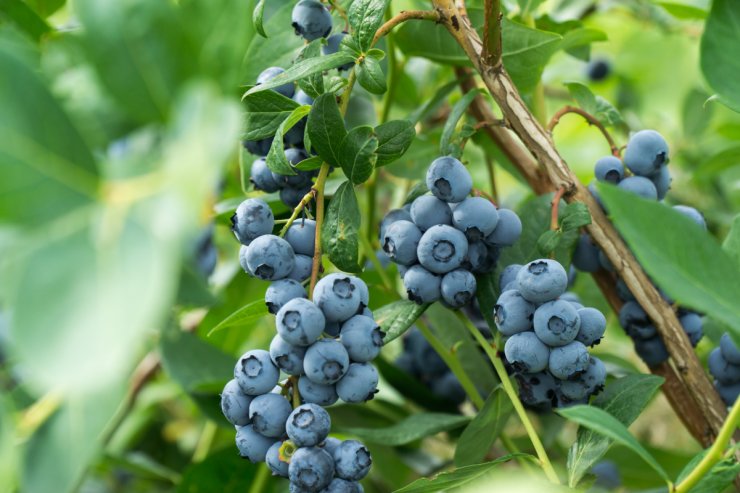
2. Blueberries
There are five species of blueberries: Lowbush, or wild blueberries; Northern highbush (Vaccinium corymbosum); Southern highbush (Vaccinium corymbosum); Rabbiteye (Vaccinium ashei); and Half-high (Vaccinium angustifolium-corymbosum hybrid). Lowbush varieties grow wild in fields and on mountaintops in northern New England and the southern Atlantic area of Canada. Northern highbush blueberries are very common at farms across New England as they produce plump, juicy berries.
Zones: Blueberries can thrive in zones 3 to 10, but pay attention to the variety, as some require more chill hours than others.
Plant spacing: Space plants 3 to 4 feet apart.
Sweetness scale: 8 to 14; blueberries can range from mild to mouth-watering sweet with an undercurrent of sourness to balance the taste.
Invasive or not: Blueberries are native to North America.
Effort: Blueberries can be easy to grow, but almost all varieties require acidic soil in order to thrive. They also require pruning in order to remain healthy. In fact, you’ll need to prune the fruit buds for the first two years before you can think about harvesting your blueberries. However, blueberry bushes can live for decades, so your patience will pay off.
Sun: Blueberries prefer full sun, but will grow in partial shade.
Size: Some varieties of blueberries can reach 12 feet tall, though it’s generally recommended to prune them to about 6 or 8 feet. The plant can spread anywhere from 4 to 8 feet.
Soil: Blueberries require plenty of organic matter and soil with an acidic pH between 4.0 and 4.8. Soil should also drain easily so the plants don’t develop root rot.
Watering: Because blueberries have shallow roots, they require consistent watering.
Companion fun fact: Blueberries make an excellent companion for blueberries! You read that right. Blueberries do not self-pollinate very easily, so it’s helpful to have a different variety of blueberry nearby.
Ready for a delicious addition to your garden? Take a look at our gardening guide, Blueberry Bonanza!
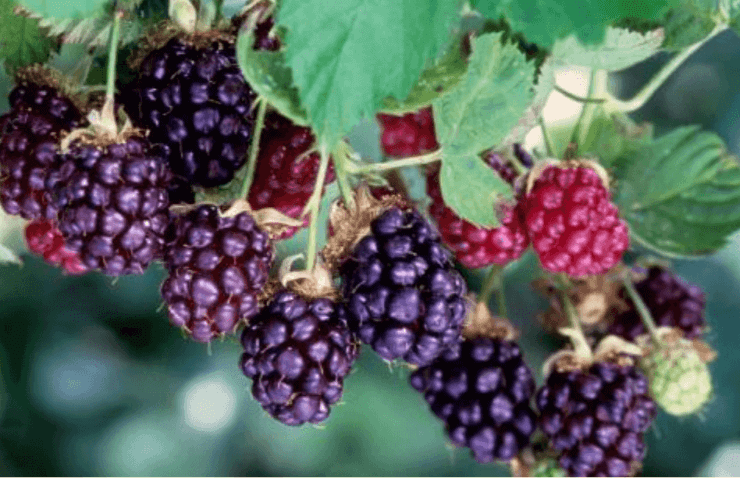
BoysonberriesImage courtesy of University of New Hampshire.
3. Boysenberry
Boysenberries (Rubus usrinus) are a cross between raspberries and blackberries, though some sources also include dewberries and loganberries in the mix. The fruit found early commercial success through the famed Knott’s Berry Farm in California, but that soon faded as the fruit does not store or travel well.
Zones: This bramble grows well in zones 6 to 9.
Plant spacing: Plant boysenberries 3 feet apart, with 8 feet between rows.
Sweetness scale: 10; juicy and sweet like the blackberry, with floral notes like the raspberry.
Invasive or not: The boysenberry is a hybrid of several native species of brambles.
Effort: Like other brambles, boysenberries produce non-fruit-bearing primocanes one year, which turn into fruit-bearing floricanes in the second year. They require regular pruning to keep them healthy, but are otherwise fairly easy to grow.
Sun: Like blackberries and raspberries, boysenberries prefer full sun.
Size: Mature boysenberry plants will reach a height of 5 to 6 feet and a width of 5 to 6 feet.
Soil: Plant boysenberries in well-drained, loamy or sandy soil with a pH of 6.0 to 7.0.
Watering: Boysenberries prefer regular moisture.
Companion fun fact: Marigolds make great companions for boysenberries, as they help control pests that may otherwise munch on your brambles.

Cranberries
4. Cranberries
The cranberry (Vaccinium macrocarpon) has a long history in North America as a vital source of nutrients for First Nations people. It wasn’t until the early 1800s that the fruit was commercially cultivated in the bogs of Cape Cod, Massachusetts. Contrary to popular belief, however, cranberries don’t grow in water. Bogs are just geological depressions filled with peat, gravel, clay, and sand. Commercial growers flood their bogs because it makes harvesting easier—cranberries float! Flooding is also used to protect the vines from winter weather.
Zones: Cranberries grow in zones 2 to 7, but you need 1 1/2 to 3 1/2 months of cool temperatures between 32 and 45 degrees F. The plants need 1,000 to 2,500 chill hours to trigger their dormant phase, so they’re ready to grow when spring arrives.
Plant spacing: Plant cranberry vines 2 to 3 feet apart.
Sweetness scale: 7 to 10; cranberries can be quite tart, but have a reasonably high sugar content.
Invasive or not: Cranberries are native to the northern United States and southern Canada.
Effort: Cranberry vines will begin producing when they are three to four years old. Cranberry vines produce runners, which in turn produce uprights, where the vine will flower and produce fruit. It’s helpful to rake the runners in one direction and prune any vines that are longer than 6 feet, so they will produce more fruit.
Sun: Cranberries prefer full sun.
Size: Cranberry plants are sometimes used as ground cover. Many varieties only grow to about 6 or 10 inches tall, though they send out vines that can reach 8 to 10 feet in length.
Soil: Cranberries enjoy “boggy” soil, with a good mix of peat and sand. They also prefer acidic soil, with a pH of 4.5 to 5.5.
Watering: Cranberry vines like consistently moist, but not soggy, soil.
Companion fun fact: Because they also like acidic soil, blueberries make a great companion for cranberries.
Want a “cran-tastic” addition to your garden? Take a look at our Cranberries Gardening Guide!
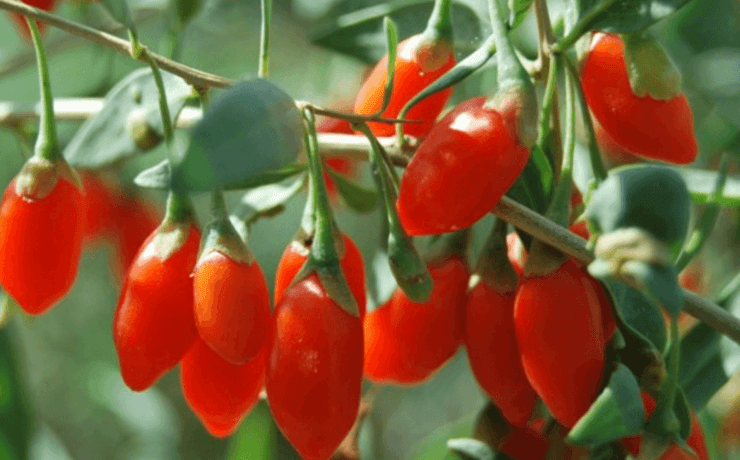
5. Goji berries
Goji berries (Lycium barbarum) are a “superfood,” due to their high concentrations of vitamins, antioxidants, amino acids, and minerals. The sweet, earthy fruit is essential in Traditional Chinese Medicine, and one legend says that herbalist Li Qing Yuen lived to the age of 252 years, thanks to his consumption of goji berries.
Zones: Goji is hardy in zones 4 to 7.
Plant spacing: 2 to 4 feet between plants in rows, with 6 to 8 feet between rows.
Sweetness scale: 13 to 15; goji berries balance sweet and sour, with some varieties tangier than others.
Invasive or not: Goji is native to southeastern Asia and southern Africa, but is considered highly invasive in some areas because it spreads so easily.
Effort: This perennial shrub is a prolific producer and is hardy to well below 0 degrees Fahrenheit. The ease with which they thrive could make goji one of the best berries to grow, but be aware that you’ll need to consistent with pruning. The roots are vigorous and spread quickly and aggressively, requiring a lot of cutting back and pruning.
Sun: Prefers full sun (six to 12 hours), but will tolerate some shade.
Size: This shrub can grow up to 10 feet tall and spread 6 to 10 feet wide.
Soil: Goji prefers light, loamy soil with a pH of 7.0 to 8.0.
Watering: Goji grows well in hot, dry conditions and will not do well if the roots are wet.
Companion fun fact: Goji plants don’t have many issues with disease or pests, although slugs and caterpillars will sometimes eat the leaves. That makes mint an excellent companion for goji. Plus, why not put all your quickly spreading plants in one spot?
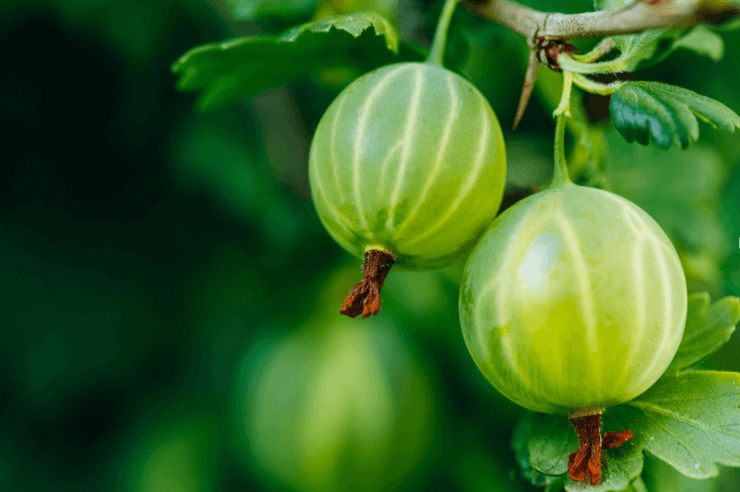
6. Gooseberries
Gooseberries are native from northern Africa to southwestern Asia to North America and grow as far north as the Arctic Circle. Interestingly, however, gooseberries are prohibited in some areas of the U.S. The plants can carry a rust disease that threatens white pine trees. Efforts by the lumber industry led to a federal ban on gooseberry plants until 1966, and the plant is still restricted in some areas, including the state of Maine and some communities in Massachusetts.
Zones: Gooseberries are hardy in zones 3 to 8, and require at least 1,000 chill hours.
Plant spacing: 3 to 5 feet apart in rows, with 8 to 10 feet between rows
Sweetness scale: 8; gooseberries can range from sour to sweet, with a taste profile similar to grapes and green apples.
Invasive or not: The plant is not invasive in the U.S., though it is prohibited in some areas.
Effort: This thorny shrub has shallow roots, and requires consistent weeding. Additionally, they need to be thinned occasionally to allow plenty of airflow among the branches. Because of the thorns, there is a bit of a learning curve with harvesting, but it’s well worth the effort.
Sun: Gooseberries grow well in partial shade to full sun.
Size: Gooseberries will reach a height of about 5 feet with a spread of 4 to 5 feet.
Soil: Gooseberries appreciate well-drained soil with plenty of organic matter and a pH between 5.5 and 7.0.
Watering: Gooseberries prefer regular moisture.
Companion fun fact: Chives make a great companion for gooseberries, as they help prevent the mildew that can impact gooseberry plants. Plus, pollinators like bees love chive blossoms.
Want to give gooseberries a try? Take a look at our gardening guide, Triumphant Gooseberries!
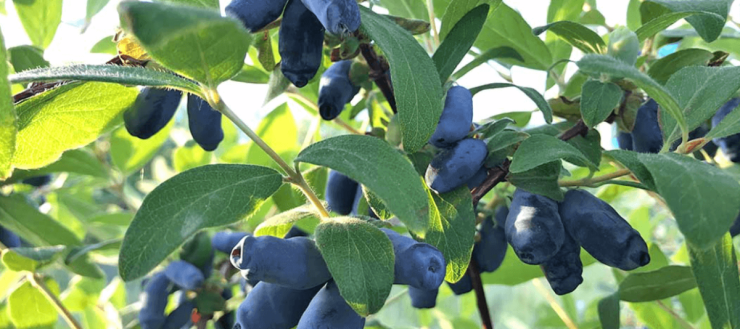
HoneyberriesImage courtesy of Montana State University.
7. Honeyberries
The honeyberry (Lonicera caerulea), which can live up to 50 years, is a species of honeysuckle and is also known as haskap. This sweet-tart berry is often compared to the blueberry in terms of taste, but some people have described it more like a blackberry or cherry. The honeyberry bush can grow to about 8 feet tall and produces elongated 1-inch berries. In cooler zones, the honeyberry bears fruit earlier than the strawberry.
Zones: Honeyberries are hardy in zones 2 to 6.
Plant spacing: Plant honeyberries 3 to 5 feet apart, but within 50 feet of another compatible honeyberry plant for cross-pollination.
Sweetness scale: 13 to 15; honeyberries not only look like blueberries, they taste very similar, too!
Invasive or not: The honeyberry plant is native to colder areas of Europe, Asia, and North America, although some sources point to Siberia and northern Japan as the original home of the plant.
Effort: If you’re looking for a low-maintenance shrub, honeyberries are definitely among the easiest and best berries to grow. Honeyberries are generally resistant to pests and disease, making them relatively easy to grow. They do require pruning starting around year five to remove older growth.
Sun: Honeyberries require full sun, although in warmer southern regions, a little shade is important for protection from the heat.
Size: Honeyberry plants will grow between 2 and 6 feet tall, with a similar spread.
Soil: Plant honeyberries in loamy, well-drained soil with a pH of 5.5 to 7.5.
Watering: Promote deep root growth by watering heavily until the plant is established, but be careful not to overwater.
Companion fun fact: Honeyberry plants attract pollinators, and they don’t overtake an area the way blackberries do. That makes them an excellent companion to fruit trees.
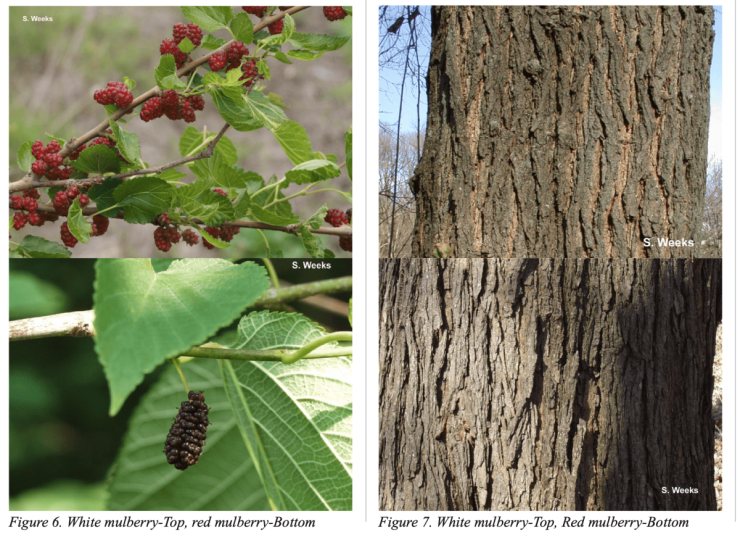
Images courtesy of Purdue University.
8. Mulberries
The mulberry is neither shrub nor bramble. In fact, it’s a tree. The two common types of mulberry trees are the red mulberry (Moris rubra) and the white mulberry (Moris alba). The red mulberry produces small, sweet black fruits, while the fruits of the white mulberry may be white, red, or black.
Zones: Mulberry trees will grow in zones 5 to 10.
Plant spacing: Space your trees 30 to 50 feet apart, and away from underground utilities.
Sweetness scale: 9 to 10; mulberries balance sweet and sour flavors with a hint of woodsy spiciness.
Invasive or not: The red mulberry is native to the Eastern United States. The white mulberry, however, is invasive, and the roots spread rapidly, often damaging underground pipes and plumbing.
Effort: Mulberry trees don’t require very much care aside from pruning any dead or broken branches in the winter.
Sun: The native red mulberry tree prefers shady, wooded areas.
Size: The mulberry tree can grow between 40 and 60 feet tall, with a similar spread.
Soil: The ideal is for moist, well-drained soil, however, mulberry trees are known for tolerating drought and poor soil.
Watering: Once your tree is established, rainfall is often sufficient.
Companion fun fact: Yarrow makes a good companion for the mulberry, as it helps attract pollinators.
9. Raspberries
Raspberries (Rubus idaeus) are one of the most popular berries across the globe. You can find raspberries in artwork, sometimes quite literally, as far back as the Middle Ages. Raspberry juice was sometimes used as a dye for paintings and illuminated manuscripts. The leaves of the raspberry are also used medicinally to brew tea that can aid in digestion.
Zones: Raspberries can grow in hardiness zones 3 to 10, although most varietals grow in zones 4 to 8.
Plant spacing: Allow 3 to 5 feet between raspberry plants, and 6 to 8 feet between rows.
Sweetness scale: 12 to 14; raspberries have a floral sweetness to them that is unmistakable.
Invasive or not: Raspberries are native to North America and the Mediterranean region.
Effort: Raspberries will grow well and produce abundant amounts of fruit with just a little upkeep. For summer-bearing raspberries, prune floricanes (the fruit-producing vines) to the ground after harvest each season to promote growth and prohibit disease. For ever-bearing raspberries, cut back the floricanes, but do not remove the primocanes (first-year growth) that produced the fall crop as they will fruit again in the summer.
Sun: Raspberries prefer a full six to eight hours of sunlight, but will grow in partial shade.
Size: Most raspberry plants will top out around 5 feet tall, with a spread of 4 to 5 feet, although some varieties will grow larger if not pruned.
Soil: Raspberries prefer loamy, moist soil with a pH of 6.0.
Watering: Raspberries need consistent moisture, but soggy soil can lead to disease.
Companion fun fact: Thyme makes a great companion for raspberries, as it helps control weeds, maintain soil moisture, and it may prevent pests such as aphids.
Don’t miss out on growing these garden gems! Take a look at our Raspberries Rule! Gardening Guide to learn more!

10. Strawberries
The modern strawberry we know today, Fragaria × ananassa, is a hybrid of species from the Americas and Eastern North America. They’re different from the wild strawberries that were consumed by indigenous communities in North America before European settlers arrived, due to extensive breeding and hybridization. These breeding efforts resulted in the larger, sweeter, and more productive strawberries that we grow today.
Zones: Strawberry plants are perennials in zones 4 to 9.
Plant spacing: Ranging from 12 to 18 inches apart in rows, with rows spaced about 24 to 36 inches apart.
Sweetness scale: Often considered a 14 to 16, offering a delightful balance of sweetness and tartness, depending on the variety and ripeness.
Invasive or not: Not invasive, but they can spread through runners and require management to prevent overcrowding.
Effort: There is minimal pruning or extra effort required, other than trimming runners, and pruning off browned leaves. Also, covering if pests or birds are an issue.
Sun: Preferred full sun exposure, ideally getting at least six hours of direct sunlight daily.
Size: Most strawberry varieties top out at 8 to 12 inches tall. However, they can spread 12 to 14 inches wide, and much more if you count the runners and daughter plants.
Soil: Strawberry plants thrive in well-drained soil that is rich in organic matter, with a pH range of 5.5 to 6.5.
Watering: Ample moisture is crucial, but waterlogged conditions should be avoided to prevent root rot.
Companion fun fact: Asparagus is a companion plant, and also a fellow perennial. They are often planted together, and won’t compete for nutrients or root space, because strawberries have shallow roots.
You can’t go wrong with strawberries. To learn more about growing your own, read Sweet! The All-Strawberry Guide!
So which are the best berries to grow in your garden?
That’s a lot to consider, I know. I usually try to decide what I’ll grow based initially on what I enjoy eating. Then my climate comes into the equation. For instance, I wouldn’t grow goji berries, since they are more suited for a hot climate. Nor would I grow a mulberry tree, as I don’t even want to consider the idea that the roots might leave me with thousands of dollars in damaged irrigation lines! Yikes! But if I had acres of land, I would definitely grow them!
I love having fresh berries of all types, especially strawberries, blueberries, raspberries, and blackberries, since they’re relatively low maintenance, and I’m pretty sure my family could live on fresh strawberries all year if that was an option.
So which are the best berries to grow? Well, I hope you’ll find some interesting ones in this list and you can narrow it down, depending on your soil, climate, and how much (or how little) effort you want to put into it. Be sure to let me know!
Have you planted any of these berries? What did you learn about growing berries that you would share with other gardeners?


 Previous
Previous
